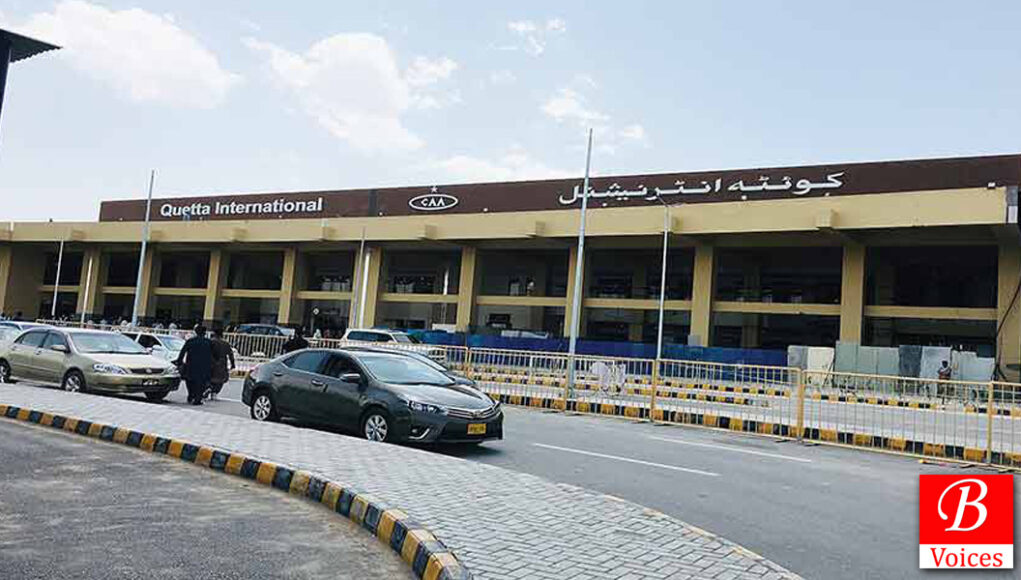Adnan Aamir
Qayyum Khan left his village early in the morning for Bacha Khan International Airport Peshawar, after he PIA confirmed via a call that his flight to Quetta was on time. While on the way to the airport, he got a text message saying that the flight had been canceled due to weather. He had to turn back to his village, frustrated with the national carrier and calculating the financial loss he had suffered for this journey. What happened to Khan, unfortunately, happens frequently to passengers traveling to and from Quetta due to the ongoing upgrade of the main runway of Quetta International Airport.
In November last year, the Civil Aviation Authority (CAA) started the upgrade on13L/31R, the main runway of Quetta International Airport so that Boeing-777s and similarly large planes can land and take off from the airport. The runway, thus, was no longer open for flight operations and the CAA asked the airlines to use the parallel, smaller runway of the Pakistan Airforce (PAF) in the meantime.
However, interviews conducted by this scribe indicate that the PAF runway currently being used does not have an integrated management system (IMS), which assists pilots during landing and take-off. Planes, therefore, have had to go through landing and take-off without the aid of a computer-guided navigation system. This requires a five-kilometer clear visibility – if that’s not the case due to cloudy weather the flight operations are suspended. Secondly, flights can only operate now between sunrise and sunset using natural light. Thirdly, strong winds are harder to deal with without the IMS equipment and prevent many flights.
This has resulted in a severe disruption of flight operations at Quetta Airport. Several private airlines have scaled down their operations from a flight a day to one or two flights per week, which also get canceled frequently. Even the VIP jet of Balochistan’s chief minister was in Islamabad for a week because it could not land due to the aforementioned problems. The disruption of flights resulted in some people traveling abroad taking as many as six Covid-19 tests over 15 days given the 48-hour validity window for the tests and frequent cancellations.
“The CAA claims that the upgrade work on the [main] runway will be complete in eight months but based on past experience we fear that it might take up to two years,” an official working in the aviation sector in Quetta tells Balochistan Voices on the condition of anonymity. He says the upgrade should have been carried out during 2020 when flight operations were suspended for several months due to Covid-19 lockdowns.
“Now that the travel industry has started recovering after the pandemic, the closure of the main runway of Quetta Airport amounts to economic strangulation,” says the official.
This issue was recently brought up in the provincial assembly. Several people from the travel industry went to meet the governor to explain the severity of the problem. However, no headway has been made so far to resume full-fledged flight operations at the Quetta Airport.
CAA officials approached for their comments had not responded to the request by the time of filing this report.
Even before the closure of the Quetta Airport runway in November last year, the standards of civil aviation were not up to the mark. This scribe too had to travel by road to make it to a visa interview or other work-related appointment in Karachi due to the last-minute cancellation of flights.
Prior to November, 40 flights were scheduled from Quetta per week. Not all of those operated, however, as cancellations were frequent. According to CAA Aviation Statistics for the fiscal year 2018-2019, 4,127 domestic and 1,354 international flights operated from all airports of Balochistan. These flights transported nearly 450,000 passengers which is very little given the 12.35 million population of Balochistan.
Qais Baloch, a travel agent working in Quetta, tells this scribe that due to the limited number of flights and uncertain flight operations, even before the closure of the runway, people traveling from Balochistan often missed medical and visa appointments in Karachi and Islamabad.
This, however, is not the only problem.
“Unlike other major cities, there are no discounted airfares for flights from Quetta. The fares make it unaffordable for many to fly,” he tells this scribe.
He adds that there is a lot of demand for Quetta-to-Karachi flights because many people wish to avoid traveling via the Quetta-Karachi highway, which is called ‘Killer Highway’ due to a large number of deadly accidents on it.
“Still there are not enough flights, which makes it very inconvenient for people from various walks of life whenever they need to travel.”
Quetta Airport is used by people from most districts of Balochistan for air travel. There is an airport in Dalbandin, situated 340 kilometers southwest of Quetta, to cater to the air travel needs of the Rakhshan division of Balochistan.
“Till February 2019, flights operated from Dalbandin to Karachi, once a week which made it easier for people to travel,” says Ali Raza Rind, a local journalist in Dalbandin. He adds that now people have to first travel five hours to Quetta and then take a flight to Karachi, which can still be canceled.
People in the Makran division use airports in Turbat and Gwadar because these areas are too far from Quetta. Only 11 flights operate from Turbat per week and just five from Gwadar, the so-called center stage for the China-Pakistan Economic Corridor (CPEC). Most flights from these airports feature small ATR planes that carry only a limited number of passengers and often get canceled.
“Twice when I reached Karachi airport to return to Gwadar, the flight was canceled. I had to fly to Turbat first and then travel from there by road to Gwadar. Not everyone can do this and it creates problems in emergency situations,” says Mariyam Suleman, a writer, and scholar. She adds that there are no daily flights from Gwadar. “[Gwadar] Airport itself is not sufficient and not built to international standards, though it is an international airport,” she says.
Share your comments!








